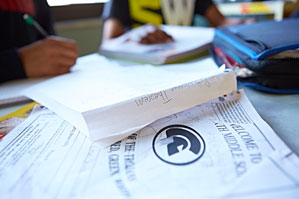Experts: Schools can't address discipline disparities without confronting racial issues
Research collaborative urges school data collection, frank conversation and adoption of new practices
The tragic deaths of Michael Brown in Ferguson, Mo., and Eric Garner in New York City have shown once again that race remains a potent dividing line in American society. A nationally recognized panel of experts has concluded it’s time to recognize that racial issues and stereotypes often shape the discipline practices of our public schools.
Students of color are being disciplined in school in far greater numbers than their white peers, often for the same type of misbehavior, notes a new research paper co-authored by Russell J. Skiba, professor in the School of Education at Indiana University Bloomington, and Mariella I. Arredondo, a research associate at the school.
“Racial disparities are not easy for Americans to confront, in large part because of a long-standing reluctance to talk about issues of race and ethnicity frankly and openly,” the researchers write. “But if we are to undo the racial inequities that continue to plague us, we must find constructive ways to talk about them and intervene constructively and consciously to end them.”
The research paper was published today by the Discipline Disparities Research-to-Practice Collaborative, a group of 26 nationally recognized experts from the social science, education and legal fields. The collaborative was assembled three years ago through The Equity Project at Indiana University, where Skiba is director and Arredondo is associate director. Earlier this year, it published an extensive analysis that challenged virtually every justification for the frequent suspension of students from the classroom.
The latest research paper offers a framework for understanding how the societal divisions created by slavery fueled inequity, segregation, conflict and stereotypes -- such as the “dangerous black male” -- that persist to this day. “Colorblind” approaches to practice and policy that ignore these persistent race issues are not sufficient, the authors write.
“Our history (has) left us with pervasive and false ideas about ‘races’ that have shaped our perceptions of who is valued and who is not, who is capable and who is not and who is ‘safe’ and who is ‘dangerous,’" the paper states.
Many educators are particularly reluctant to discuss how they discipline their black students, fearing their comments will be “misinterpreted” and that they will be labeled racist, the paper noted. But progress toward eliminating discipline disparities can’t be achieved without acknowledging and addressing common issues of race that shape adult-student interactions in schools that are effectively segregated or under-resourced.
The paper offers an analogy: “Imagine a school district with consistently low reading achievement scores, yet within that district an unwritten code prevented staff from explicitly discussing the topic of reading. Obviously, the failure to address the central problem would guarantee that reading deficits would persist over time.
“In the same way, in part because we don’t discuss and then address the racial dynamics of our racially disproportionate discipline, racial disparities in discipline continue to worsen over time.”
Recent evidence shows that disparities in school discipline are indeed continuing to worsen. According to the latest federal data, released in March, black students are suspended and expelled at a rate three and a half times greater than white students. On average, 5 percent of white students are suspended compared to 16 percent of black students. Black girls are suspended at higher rates, 12 percent, than girls of any other race. And even among the youngest children, black students make up 18 percent of preschool enrollment but 48 percent of the preschool children who have received more than one suspension.
To truly acknowledge and confront the issue of race at the heart of racial disparities, the researchers argue that schools and school systems need to engage in a series of steps: First, educators need to gather detailed disciplinary data that can be examined for patterns of discipline and suspension by gender, race, age, reason for suspension and the educators involved.
That data then can be used to inform school and district discussions among principals, teachers and community members about why certain students, especially students of color, are being suspended and expelled at a higher rate. Those conversations, in turn, can support the implementation of new disciplinary approaches that minimize suspensions.
“Schools and districts will make the most progress if data open a door to reflective and critical conversations about the ways in which school processes, adult actions and adult interactions with students may contribute to disciplinary outcomes,” the researchers conclude. “While some clumsy or incomplete race talk can in fact create harm, our reticence to talk frankly about issues of race prevents us from even considering the steps we need to take to fix racial discipline disparities.”
The Discipline Disparities Collaborative was launched with funding from the Atlantic Philanthropies and the Open Society Foundations. Its latest research paper, "You Can’t Fix What You Don’t Look At: Acknowledging Race in Addressing Racial Discipline Disparities," follows the issuance in January of new guidance from the federal government reminding school systems of their civil rights obligations in administering discipline. It also follows the launch of President Obama’s “My Brother’s Keeper” initiative to help boys of color succeed in life and the release in June by the Council of State Governments of a massive catalog of promising strategies that can be used to improve the disciplinary systems of public schools.
Authors of the research paper, in addition to Skiba and Arredondo, are Prudence L. Carter, professor of education at Stanford University; and Mica Pollock, professor of education at the University of California, San Diego.

